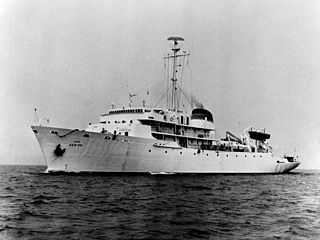
Alvin (DSV-2) is a crewed deep-ocean research submersible owned by the United States Navy and operated by the Woods Hole Oceanographic Institution (WHOI) in Woods Hole, Massachusetts. The vehicle was built by General Mills' Electronics Group in Minneapolis, Minnesota. Named to honor the prime mover and creative inspiration for the vehicle, Allyn Vine, Alvin was commissioned on 5 June 1964. The submersible is launched from the deep submergence support vessel RV Atlantis (AGOR-25), which is also owned by the U.S. Navy and operated by WHOI. The submersible has made more than 5,000 dives, carrying two scientists and a pilot, to observe the lifeforms that must cope with super-pressures and move about in total darkness, as well as exploring the wreck of Titanic. Research conducted by Alvin has been featured in nearly 2,000 scientific papers.

Robert Duane Ballard is an American retired Navy officer and a professor of oceanography at the University of Rhode Island who is most noted for his work in underwater archaeology: maritime archaeology and archaeology of shipwrecks. He is most known for the discoveries of the wrecks of the RMS Titanic in 1985, the battleship Bismarck in 1989, and the aircraft carrier USS Yorktown in 1998. He discovered the wreck of John F. Kennedy's PT-109 in 2002 and visited Biuku Gasa and Eroni Kumana, who saved its crew. He leads ocean exploration on E/V Nautilus. Ballard considers his most important discovery to be that of hydrothermal vents.

The Scripps Institution of Oceanography in San Diego, California, founded in 1903, is one of the oldest and largest centers for ocean and Earth science research, public service, undergraduate and graduate training in the world. Hundreds of ocean and Earth scientists conduct research with the aid of oceanographic research vessels and shorebased laboratories. Its Old Scripps Building is a U.S. National Historic Landmark. SIO is a division of the University of California San Diego (UCSD). The public explorations center of the institution is the Birch Aquarium at Scripps. Since becoming part of the University of California in 1912, the institution has expanded its scope to include studies of the physics, chemistry, geology, biology, and climate of Earth.

A Small Waterplane Area Twin Hull, better known by the acronym SWATH, is a twin-hull ship design that minimizes hull cross section area at the sea's surface. Minimizing the ship's volume near the surface area of the sea, where wave energy is located, maximizes a vessel's stability, even in high seas and at high speeds. The bulk of the displacement necessary to keep the ship afloat is located beneath the waves, where it is less affected by wave action. Wave excitation drops exponentially as depth increases, so wave action normally does not affect a submerged submarine at all. Placing the majority of a ship's displacement under the waves is similar in concept to creating a ship that rides atop twin submarines.

A research vessel is a ship or boat designed, modified, or equipped to carry out research at sea. Research vessels carry out a number of roles. Some of these roles can be combined into a single vessel but others require a dedicated vessel. Due to the demanding nature of the work, research vessels are often constructed around an icebreaker hull, allowing them to operate in polar waters.
The Argo is the ship captained by Jason in Greek mythology.
USS Atlantis may refer to the following ships operated by the United States Navy:

RV Knorr was a research vessel formerly owned by the U.S. Navy and operated by the Woods Hole Oceanographic Institution for the U.S. research community in coordination with and as a part of the University-National Oceanographic Laboratory System (UNOLS) fleet. On March 14, 2016, Knorr was officially transferred to the Mexican Navy and renamed Rio Tecolutla. She was replaced at Woods Hole by the RV Neil Armstrong. Knorr is best known as the ship that supported researchers as they discovered the wreck of the RMS Titanic in 1985. R/V Knorr (AGOR-15) has traveled more than a million miles—the rough equivalent of two round trips to the Moon or forty trips around the Earth. Her sister ship is the RV Melville.

USS Snatch (ARS-27), well known as Scripps R/V Argo after conversion to scientific research, was a Diver-class rescue and salvage ship commissioned by the U.S. Navy during World War II and in service from 11 December 1944 through 23 December 1946. Her task was to come to the aid of stricken vessels. The ship is better known from her scientific research role as the Scripps Institution of Oceanography (SIO) research vessel R/V Argo. It is that name, apparently not formally recognized by Navy that maintained title to the vessel, found in the scientific literature and public releases about her wide ranging research voyages.
Two ships of the United States Navy have borne the name Melville, in honor of George W. Melville, an engineer and arctic explorer.
Two ships of the United States Navy have borne the name Thomas G. Thompson, in honor of oceanographer Thomas G. Thompson (1888–1961).
RV Pacific Escort is a name used more than once by the U.S. Navy:

USNS Silas Bent (T-AGS-26) was a Silas Bent class survey ship acquired by the United States Navy in 1964 and delivered to the Military Sealift Command in 1965. Silas Bent spent her career in the Pacific Ocean performing oceanographic surveys. The ship was equipped with the Oceanographic Data Acquisition System (ODAS) as were the later oceanographic survey ships USNS Kane (T-AGS-27) and USNS Wilkes (T-AGS-33).
Oceanus is the personification of the world-ocean in Greek myth.

RV Horizon, ex Auxiliary Fleet Tug ATA-180, was a Scripps Institution of Oceanography research vessel from 1949 through 1968. During that time she made 267 cruises and logging 610,522 miles (982,540 km) spending 4,207 days at sea.

The Japan Agency for Marine-Earth Science and Technology, or JAMSTEC (海洋機構), is a Japanese national research institute for marine-earth science and technology. It was founded as Japan Marine Science and Technology Center (海洋科学技術センター) in October 1971, and became an Independent Administrative Institution administered by the Ministry of Education, Culture, Sports, Science and Technology (MEXT) in April 2004.

RV Neil Armstrong (AGOR-27) is the designation for a new oceanographic research ship, first of the Neil Armstrong-class research vessels, to be owned by the United States Navy and operated by Woods Hole Oceanographic Institution. Secretary of the Navy Ray Mabus announced on September 24, 2012 that the research vessel was to be named after Neil Armstrong, the first person to walk on the Moon and a former naval aviator who served in the Korean War.

RV Sally Ride (AGOR-28) is a Neil Armstrong-class research vessel owned by the United States Navy and operated by the Scripps Institution of Oceanography. The ship was named for Sally Ride, a US astronaut.
This page is based on this
Wikipedia article Text is available under the
CC BY-SA 4.0 license; additional terms may apply.
Images, videos and audio are available under their respective licenses.











